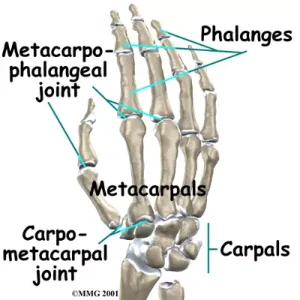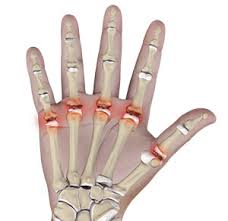
 The metacarpophalangeal joints (MCP) are situated between the metacarpal bones and the proximal phalanges of the fingers.
The metacarpophalangeal joints (MCP) are situated between the metacarpal bones and the proximal phalanges of the fingers.
These joints are formed by the reception of the rounded heads of the metacarpal bones into shallow cavities on the proximal ends of the proximal phalanges.
Being condyloid joints they allow the movements of flexion, extension, abduction, adduction and circumduction at the joint.
Ligaments
edit
Metacarpophalangeal articulation and articulations of digit. Palmar aspect.
Metacarpophalangeal articulation and articulations of digit.
Each joint has:
palmar ligaments of metacarpophalangeal articulations
collateral ligaments of metacarpophalangeal articulations
Dorsal surfaces
The dorsal surfaces of these joints are covered by the expansions of the Extensor tendons, together with some loose areolar tissue which connects the deep surfaces of the tendons to the bones.
The movements which occur in these joints are flexion, extension, adduction, abduction, and circumduction.
Movements of abduction and adduction are very limited, and cannot be performed while the fingers form a fist.
The muscles of flexion and extension are as follows:
Ffingers flexion: Flexor digitorum superficialis and profundus, lumbricals, and interossei, assisted in the case of the little finger by the flexor digiti minimi brevis
Extension: extensor digitorum communis, extensor indicis proprius, and extensor digiti minimi muscle
Thumb
flexor pollicis longus and brevis
extensor pollicis longus and brevis
Arthritis of the MCP is a distinguishing feature of rheumatoid arthritis, as opposed to the distal interphalangeal joint in osteoarthritis.
